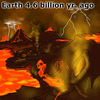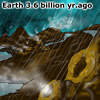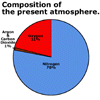Our Earth has a unique mixture of gases surrounding it that allows life, as we know it, to exist. The current atmosphere is the product of 4.6 billion years of changes in the geology of the Earth, coupled with the evolution of life in its many forms. This topic investigates the composition of our atmosphere. The topic The structure of the atmosphere investigates the physical structure and properties of the atmosphere.
The origin of the atmosphere
 When
the Earth first started to form 4.6 billion years ago, the first atmosphere
was probably made mainly of hydrogen and helium. These two gases make
up most of the matter in the Solar System and are still present in huge
quantities in the outer gas planets.
When
the Earth first started to form 4.6 billion years ago, the first atmosphere
was probably made mainly of hydrogen and helium. These two gases make
up most of the matter in the Solar System and are still present in huge
quantities in the outer gas planets.
 During
the first billion years, these light gases quickly escaped the Earth's
gravitational attraction and were replaced with carbon dioxide, water
vapour and nitrogen from the large number of volcanoes that existed as
the Earth started to cool. This pre-life atmosphere contained over 90%
carbon dioxide, 5% nitrogen, 2-3% sulfur dioxide and traces of hydrogen
sulphide, ammonia and methane, but no oxygen. It was hot, smelly and deadly
poisonous!
During
the first billion years, these light gases quickly escaped the Earth's
gravitational attraction and were replaced with carbon dioxide, water
vapour and nitrogen from the large number of volcanoes that existed as
the Earth started to cool. This pre-life atmosphere contained over 90%
carbon dioxide, 5% nitrogen, 2-3% sulfur dioxide and traces of hydrogen
sulphide, ammonia and methane, but no oxygen. It was hot, smelly and deadly
poisonous!
 As
the Earth cooled and volcanic activity subsided, water vapour started
to condense forming the first clouds and huge rain storms. Rivers, lakes
and oceans started to appear, which then set in place the chemistry and
conditions required for life to start.
As
the Earth cooled and volcanic activity subsided, water vapour started
to condense forming the first clouds and huge rain storms. Rivers, lakes
and oceans started to appear, which then set in place the chemistry and
conditions required for life to start.
Life and the atmosphere
What happened to change this primitive atmosphere to today's far more
life friendly atmosphere? The answer is life itself.
Some 3.8 billion years ago, the first life forms appeared in the oceans. These ancient bacteria lived on carbon dioxide and the other gases in the atmosphere, expelling oxygen gas as waste. For another billion years these carbon dioxide breathing life forms kept consuming the carbon dioxide and making oxygen, until the next great change occurred in the atmosphere's composition.
Around 2.5 billion years ago, the oxygen in the atmosphere had increased to such an extent that it had become poisonous to the early bacteria. New bacteria and other simple life forms evolved to use the oxygen. The first great divide in life had occurred, the ancient life forms continued to consume carbon dioxide and give off oxygen gas while the new ones consumed oxygen and gave off carbon dioxide.
The complementary actions of these life forms created a new composition
of gases in the Earth's atmosphere resulting in today's atmosphere.
 Today's
atmosphere
Today's
atmosphere
The composition of the current atmosphere is 78% nitrogen, 21% oxygen,
1% argon with only 0.03% carbon dioxide. These proportions are for clean
dry air; the water content in air can vary greatly from nearly none in
the driest deserts to about 4% in the tropics.
The nitrogen remains from the original ancient atmosphere and undergoes a natural cycle with bacteria in soil as well as nitrogen in plants and animals. The carbon dioxide - oxygen balance is held in check by the complementary actions of photosynthesis in plants (making oxygen from carbon dioxide) and respiration in plants and animals (consuming oxygen and producing carbon dioxide). Natural fires also help keep the two in balance.
 Although
carbon dioxide is only present in small quantities, it has a large effect
on our climate. Without carbon dioxide, the Earth would have an average
temperature of about -18°C. See the topic The
greenhouse effect for more on the effect of carbon dioxide on weather.
Although
carbon dioxide is only present in small quantities, it has a large effect
on our climate. Without carbon dioxide, the Earth would have an average
temperature of about -18°C. See the topic The
greenhouse effect for more on the effect of carbon dioxide on weather.
Ozone is also present in trace quantities, but is also very important
to life on Earth. Ozone helps to shield the Earth's surface from dangerous
ultraviolet radiation from the Sun. See the two topics on ozone depletion:
The hole in the ozone layer
A: What is it? and The hole
in the ozone layer B: The players for more on how the ozone in our
atmosphere protects us from very nasty sunburn!
The composition of the atmosphere is the creation of the Earth's geology and life. There is a dynamic balance between life, geology and the atmosphere. Any changes to the geology of the Earth or to the balance of life can affect the atmosphere, similarly changes in the atmosphere affect life on Earth. If the balance is disrupted, dramatic effects are possible. We are a very important life form when it comes to the atmosphere; clearing trees, burning fossil fuels, polluting the air, all have an effect. What the effect is, we are not sure!
| Copyright owned by the State of Victoria (Department of Education and Early Childhood Development). Used with Permission. |